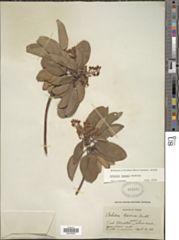Project 4968: W. L. Crepet, K. C. Nixon, A. Weeks. 2018. Mid-Cretaceous angiosperm radiation and an asterid origin of bilaterality: diverse and extinct "Ericales" from New Jersey. American Journal of Botany. 105 (8):1412-1423.
Abstract
Premise of the StudyNumerous fossils from the Upper Cretaceous have been confidently placed within modern crown groups. Many 95–75 Myr-old taxa, however, including the taxon described herein, do not fit well with known extant crown or stem groups. Understanding such fossils and their possible affinities would certainly enhance our understanding of the circumstances involved in a major eudicot radiation.MethodsBulk samples from the Old Crossman Clay Pit were prepared using standard methodology, which includes several washing and sieving steps, and a treatment with hydrofluoric acid. The fossil taxon was coded into a matrix built from the combination of two previously published morphological matrices and was analyzed using the parsimony criterion with the computer program TNT.Key ResultsThe fossils have a unique combination of characters relative to living and fossil Ericales taxa, and therefore, a new genus, Teuschestanthes, is erected. Mosaic evolution and rapid parallel changes in such groups blur taxonomic distinctions, and these issues are exacerbated by limited numbers of characters available in fossils. Teuschestanthes flowers are slightly bilaterally symmetrical and somewhat variable with regard to petal disposition, suggesting an early stage in transition to bilaterality from radial symmetry early in eudicot history under pollinator selective pressure.ConclusionsWhile Teuschestanthes shares characters with modern Ericales and Sapindales, there are significant non-overlapping differences between Teuschestanthes and modern Sapindales (notably, among others, ovule number). Based on available evidence, however, the position of Teuschestanthes is likely as an early offshoot of the stem clade of core Ericales (Ericales sensu stricto). Its relatively unstable floral plan may presage subsequent bilaterality associated with growing selective pressure by advanced pollinators.Read the article »
Article DOI: 10.1002/ajb2.1131
Project DOI: 10.7934/P4968, http://dx.doi.org/10.7934/P4968
| This project contains |
|---|
Download Project SDD File |
Currently Viewing:
MorphoBank Project 4968
MorphoBank Project 4968
- Creation Date:
27 November 2023 - Publication Date:
27 November 2023
Authors' Institutions ![]()
- Cornell University
- George Mason University

